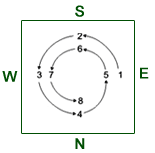Dealing the tiles / Breaking the wall
| a. |
The 144 pieces, including flowers & seasons (or 136 without flowers & seasons) are mixed and then placed faced down on the table. Each player then selects 36 tiles (or 34 without flowers & seasons) and arranges them face down in a row of 18 pieces (or 17 pieces without flowers & seasons) and 2 tiles high. Then, these rows are pushed forward to form a hollow square in the middle of the table. Below is an example of an unbroken wall: |

|
| b. |
To determine which side of the wall to be the starting point, East throws the three dice and counts counterclockwise round the walls, beginning with himself as one (accordingly, numbers 5, 9, 13, and 17 indicate East, numbers 2, 6, 10, 14, 18 indicates South, numbers 3, 7, 11, 15 indicates West and numbers 4, 8, 12 and 16 indicates North).
|

|
| c. |
The player indicated then counts off along the tiles of his side of the wall, starting from the right end. Then, this player makes a break in the wall by pushing slightly the tiles to the left of the breaking point. The seven stacks of tiles to the right of the breaking point are known as Dead Wall (or Kong box); the remaining tiles, starting from the tiles to the left of the breaking point, constitute the Live Wall. The 14 tiles of the Dead Wall are reserved as replacement tiles for Kongs (and Flowers and Seasons, if they are used). The Dead Wall is replenishing so the used supplement tiles are replaced by reserving new tiles from the tail end of the live Wall (however, the supplement tiles are always taken from the left end of the Dead Wall).
|

|
| d. |
East starts the deal by taking the first two stacks of the tiles (i.e., four tiles) from the left of the break, then each of the other three players pick two stacks of tiles in order South, West and North. This is repeated twice so that each player has 12 tiles. East then draws the next stack of two tiles, and South, East and North in turn take one tile each. Thus the dealer has 14 tiles and the other three players each 13 tiles.
|

|
|
The players take each 2 stacks of tiles (i.e., four tiles at a time) from the start of the live Wall, in order East, South, West and North, until each player has 12 tiles. Then East picks one more stack of two tiles and West, South and North pick one tile each (see picture).
|

|
|
Note. A very common variation is that East picks his 13th and 14th tile as illustrated in picture above (note that these two tiles are picked at the same time and South, West and North pick their final tiles only after this). This is called chan-chan because of the sound made by the clicking of the two tiles.
|
| e. |
If the dealt hand contains Flowers or Seasons, they are immediately melded (placed face up above and to the side of the hand) and replaced with regular tiles taken from the Dead Wall (East replaces first his extra tiles, then South, West and North). Should a player draw further bonus tiles during this replacement procedure, he immediately takes supplement tiles for these, as well. If a player has a concealed Kong(s) in his hand he may declare it (them) at the same time he takes supplement tiles for Flowers and Seasons.
|
|
|